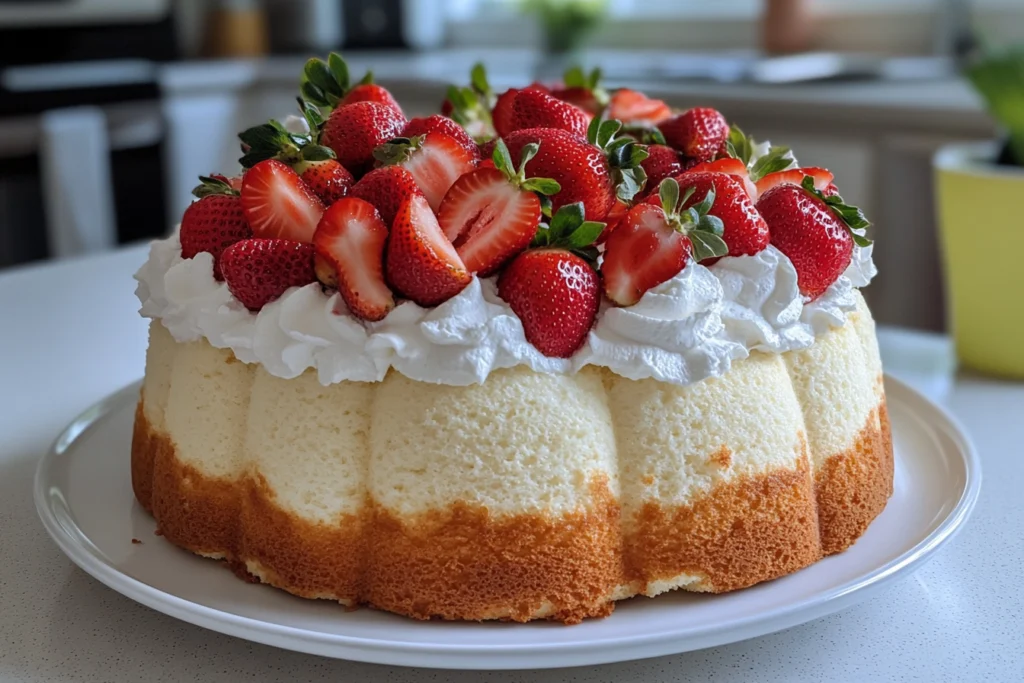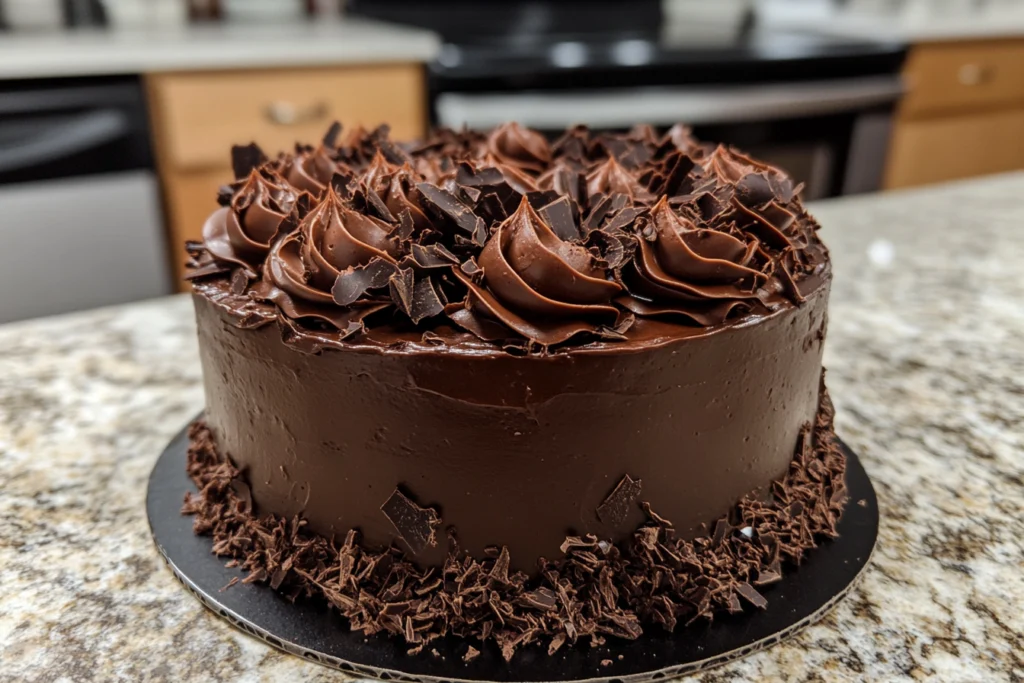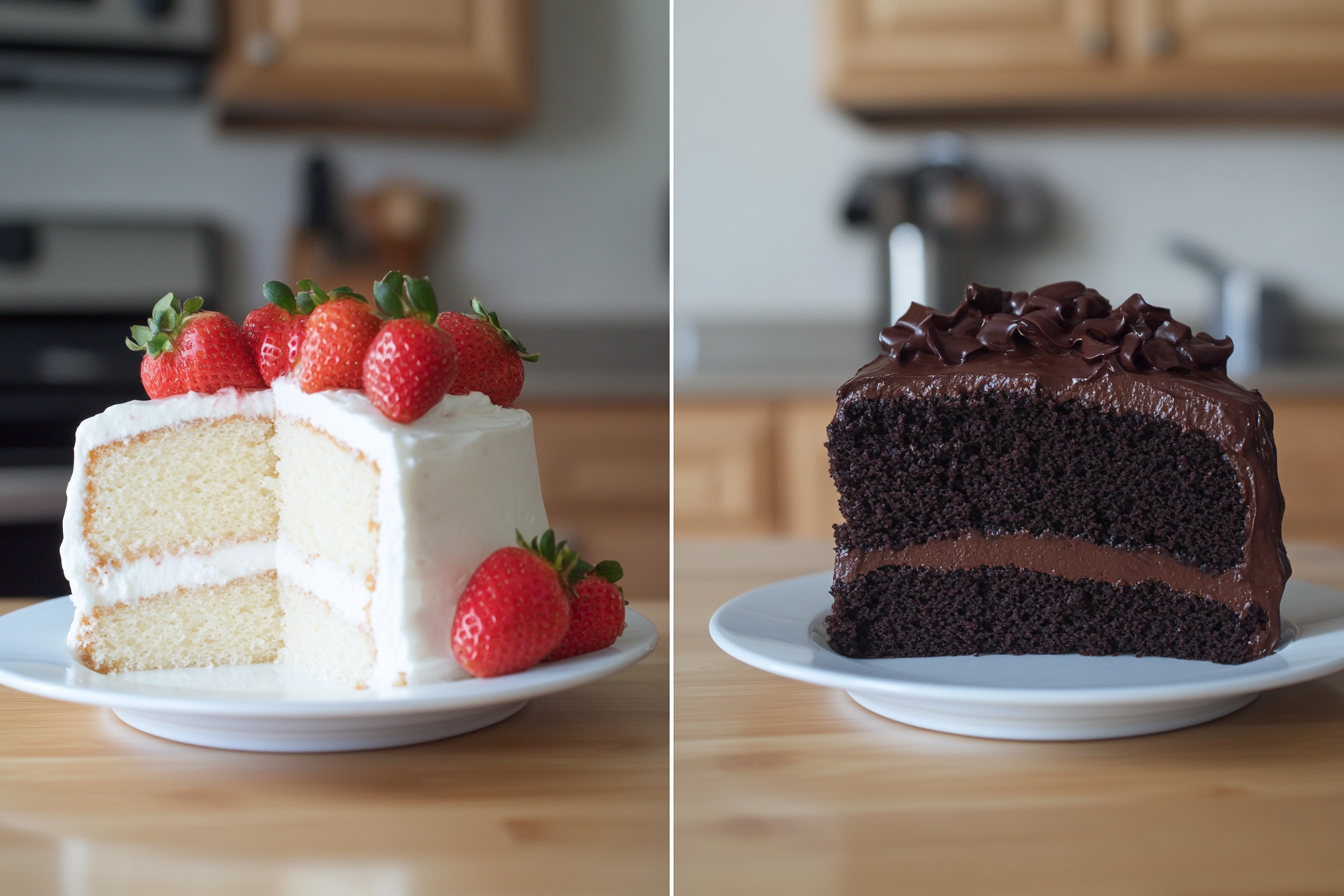Introduction
When it comes to desserts, cakes often take center stage, and two standout options are angel food cake and devil’s food cake. While their names suggest polar opposites, these cakes differ not only in flavor and appearance but also in texture, ingredients, and even the occasions they’re best suited for. Whether you’re a fan of the airy lightness of angel food or the indulgent richness of devil’s food, understanding what sets them apart can enhance your baking knowledge and dessert choices. Let’s dive into these two iconic cakes and explore their unique characteristics!
Understanding Angel Food Cake
What is Angel Food Cake?
Angel food cake is a feather-light dessert with a delicate texture that seems to melt in your mouth. This unique cake is named for its ethereal qualities, as many consider it light enough for angels. Originating in the United States during the 19th century, it quickly gained popularity due to its simple yet ingenious use of egg whites as a primary ingredient. With no added fats like butter or oil, this cake boasts an unmistakable spongy structure that’s both sweet and subtle in flavor.
Ingredients in Angel Food Cake
The simplicity of angel food cake’s recipe is part of its charm. Its core ingredients include:
- Egg whites: Provide structure and an airy texture.
- Sugar: Adds sweetness and stabilizes the whipped egg whites.
- Cake flour: Contributes to a delicate crumb.
- Cream of tartar: Helps stabilize the egg whites and maintain their volume.
- Vanilla extract: Adds a touch of flavor.
What sets it apart from most cakes is the absence of fats like butter or oil, making it relatively low in calories compared to denser desserts.
Baking Process for Angel Food Cake
Making angel food cake requires precision and care, particularly when whipping the egg whites. Here’s an overview:
- Step 1: Begin by separating the egg whites from the yolks. Ensure no yolk contaminates the whites, as even a trace of fat can prevent proper whipping.
- Step 2: Whip the egg whites in a grease-free bowl until frothy, then add cream of tartar. Gradually increase the speed and add sugar slowly, creating a glossy, stiff meringue.
- Step 3: Sift the cake flour and gently fold it into the meringue to maintain its airy structure.
- Step 4: Transfer the batter into an ungreased tube pan. The ungreased surface allows the batter to cling to the sides as it rises.
- Step 5: Bake for 35 to 40 minutes at 350°F (175°C), or until the top is golden brown and bounces back when you touch it.
- Step 6: Invert the pan immediately after baking to prevent the cake from collapsing as it cools.
Nutritional Profile of Angel Food Cake
Compared to other cakes, angel food cake is a lighter choice. The following is its nutritional value per 100 grams:
| Nutrient | Amount |
|---|---|
| Calories | 258 kcal |
| Protein | 6.5 g |
| Fat | 0.2 g |
| Carbohydrates | 58 g |
| Fiber | 0.3 g |
| Sugar | 41 g |

Exploring Devil’s Food Cake
What is Devil’s Food Cake?
In stark contrast to the light and airy angel food cake, devil’s food cake is rich, indulgent, and utterly decadent. Known for its deep chocolate flavor and moist texture, this cake earned its name as a tempting counterpart to angel food cake. Believed to have originated in the early 1900s, devil’s food cake epitomizes chocolate desserts at their finest, featuring a dark and velvety crumb that appeals to chocolate lovers everywhere.
Ingredients in Devil’s Food Cake
The luxurious richness of devil’s food cake comes from its carefully chosen ingredients:
- Cocoa powder: Provides the signature dark chocolate flavor.
- Butter: Adds moisture and richness.
- Granulated sugar: Sweetens and balances the bitterness of cocoa.
- Eggs: bind the components together and add to the framework.
- All-purpose flour: Ensures a sturdy yet tender crumb.
- Baking soda: Reacts with acidic ingredients for a darker color and tender texture.
- Buttermilk: Adds tanginess and enhances moisture.
- Vanilla extract: Complements the chocolate flavor.
The addition of baking soda and buttermilk gives the cake its unique texture and dark appearance, distinguishing it from standard chocolate cakes.
Baking Process for Devil’s Food Cake
Creating the perfect devil’s food cake requires patience and precision. Follow these steps for a flawless bake:
- Step 1: Preheat the oven to 350°F (175°C) and prepare two round cake pans by greasing and flouring them.
- Step 2: Beat the sugar and butter until they are light and fluffy. By adding air to the batter, this stage guarantees a soft crumb.
- Step 3: Beat in the eggs one at a time, mixing thoroughly after each addition. Add vanilla extract for enhanced flavor.
- Step 4: In a separate bowl, whisk together the dry ingredients: flour, cocoa powder, baking soda, and salt.
- Step 5: Add the dry ingredients to the wet mixture gradually, switching between them and the buttermilk. Mix the dry ingredients first and last until they are barely mixed.
- Step 6: Divide the batter evenly between the prepared pans and bake for 30–35 minutes. The cakes are done when a toothpick inserted into the center comes out clean.
- Step 7: After letting the cakes cool in the pans for ten minutes, move them to a wire rack to finish cooling.
Nutritional Profile of Devil’s Food Cake
Devil’s food cake, with its richness, is a calorie-dense dessert. Its nutritional content per 100 grams is as follows:
| Nutrient | Amount |
|---|---|
| Calories | 390 kcal |
| Protein | 5.2 g |
| Fat | 18 g |
| Carbohydrates | 53 g |
| Fiber | 3 g |
| Sugar | 36 g |

Key Differences Between Angel Food Cake and Devil’s Food Cake
Appearance and Texture Differences
The most noticeable distinction between angel food cake and devil’s food cake lies in their appearance and texture. Angel food cake boasts a light, airy structure with a snowy white interior and a golden-brown crust. Its sponge-like consistency is created by whipped egg whites and the absence of fat, making it almost ethereal in texture.
In contrast, devil’s food cake is dense and moist, with a deep chocolate hue that immediately signals its indulgent flavor. This cake has a velvety crumb and a richer, heavier mouthfeel, thanks to the butter and cocoa powder used in its batter.
Flavor Profiles Compared
The flavor profiles of these two cakes are as different as day and night. Angel food cake offers a subtle sweetness with hints of vanilla, making it a versatile base for toppings like fresh fruit or whipped cream. Its delicate flavor pairs well with light accompaniments, ensuring it doesn’t overpower the palate.
Devil’s food cake, on the other hand, is intensely chocolatey and deeply satisfying. The rich cocoa flavor is bold and unmistakable, often enhanced by the addition of dark chocolate frosting or ganache. Its flavor profile caters to those seeking a dessert with depth and complexity.
Ingredient Variations
The ingredients used in these cakes are another area where their differences shine. Angel food cake relies on a minimalistic recipe that omits fats, focusing on egg whites, sugar, and flour. The absence of butter or oil is critical for achieving its signature lightness.
Meanwhile, devil’s food cake features a more indulgent ingredient list, including butter, cocoa, and buttermilk. The combination of these rich ingredients creates its moist and luxurious texture. Additionally, the use of baking soda in devil’s food cake contributes to its darker color and tender crumb.
Preparation and Baking Contrasts
The preparation of these cakes further highlights their differences. Angel food cake requires precision, especially when whipping egg whites to the perfect stiffness. Careful folding of flour ensures the batter retains its airiness, and baking it in an ungreased tube pan helps it rise uniformly.
Devil’s food cake involves creaming butter and sugar to create a fluffy base before combining it with the dry ingredients and buttermilk. The batter is richer and denser, baked in greased pans to prevent sticking and ensure even layers for decorating.
Making a Decision Between Devil’s Food Cake and Angel Food Cake
When to Serve Angel Food Cake
Angel food cake is the perfect choice for occasions when a lighter dessert is desired. Its low-fat content and delicate flavor make it a crowd-pleaser for summer gatherings, bridal showers, or tea parties. This cake pairs wonderfully with fresh berries, a dollop of whipped cream, or even a drizzle of fruit syrup, making it a versatile option for warm-weather celebrations.
Additionally, angel food cake’s low-calorie profile makes it a guilt-free treat for those watching their dietary intake. Its fluffy, sponge-like texture ensures it won’t feel heavy, even after a hearty meal.
When to Serve Devil’s Food Cake
Devil’s food cake is a dessert designed for indulgence, making it an excellent choice for special celebrations like birthdays, anniversaries, or holidays. Its rich, chocolatey flavor is the ultimate treat for chocolate lovers, and it pairs beautifully with decadent toppings like ganache, buttercream frosting, or even a scoop of vanilla ice cream.
This cake’s dense texture and bold flavor can hold their own against a variety of sweet pairings, from caramel to chocolate shavings. It’s a showstopper dessert that leaves a lasting impression.
Tips for Personalizing Each Cake
While angel food cake and devil’s food cake are delicious in their classic forms, they can be customized to suit personal preferences:
- Angel Food Cake Variations:
- Incorporate the zest of an orange or lemon into the batter to give it a citrus edge.
- Top with a fruit compote or a thin layer of light glaze for added sweetness.
- Layer with whipped cream and berries for a trifle-style presentation.
- Devil’s Food Cake Variations:
- Enhance the chocolate flavor by using high-quality dark cocoa or adding espresso powder to the batter.
- Create a layered masterpiece with chocolate mousse or a peanut butter frosting filling.
- Experiment with toppings like salted caramel drizzle or a sprinkle of crushed nuts.
No matter how you serve these cakes, their distinctive qualities ensure they’ll be memorable desserts for any occasion.
FAQs
What is the origin of Angel Food Cake?
Angel food cake is believed to have originated in the United States during the late 19th century. Its creation is often attributed to the advent of more advanced kitchen tools, such as rotary egg beaters, which made whipping egg whites easier. The cake became popular due to its simplicity and light, airy texture, which contrasted with the heavier desserts of the time.
Why is Devil’s Food Cake called “devil”?
The name “devil’s food” is a playful reference to the cake’s indulgent, almost sinful richness. The dark color and deep chocolate flavor were seen as the antithesis of the light, heavenly qualities of angel food cake, creating a thematic contrast that has endured for generations.
Can Angel Food Cake be made with whole eggs?
No, whole eggs cannot be used in angel food cake. The recipe specifically relies on egg whites for structure and aeration. Egg yolks contain fat, which would weigh down the batter and prevent the cake from achieving its characteristic light and fluffy texture.
How do you store each type of cake?
- Angel Food Cake: This cake is best stored at room temperature, tightly wrapped in plastic wrap to retain moisture. It can also be frozen for longer storage, but it’s recommended to thaw it at room temperature for optimal texture.
- Devil’s Food Cake: Due to its richer composition, devil’s food cake should be stored in an airtight container at room temperature for up to three days or refrigerated if it contains perishable frosting.
Are there gluten-free options for both cakes?
Yes, both cakes can be made gluten-free with some modifications. For angel food cake, substitute regular cake flour with a gluten-free flour blend designed for baking. Similarly, devil’s food cake can be adapted using gluten-free flour, but ensure that all other ingredients, such as baking soda and cocoa powder, are also gluten-free.
What is the best topping for Angel Food Cake?
The best toppings for angel food cake are light and complementary to its delicate flavor. Fresh fruit like strawberries, raspberries, or blueberries adds a burst of natural sweetness, while whipped cream or a drizzle of honey can enhance the cake without overpowering it.
Wrapping It All Up: Angel Food Cake vs. Devil’s Food Cake
Angel food cake and devil’s food cake are more than just desserts—they’re culinary representations of opposites that appeal to different tastes and occasions. Angel food cake, with its light, fluffy texture and low-fat ingredients, is ideal for those seeking a subtly sweet treat. It’s perfect for warm days or when a lighter dessert is called for. Its simplicity allows it to pair beautifully with fresh fruit and other delicate toppings.
On the other hand, devil’s food cake, with its rich chocolate flavor and moist, dense crumb, is the embodiment of indulgence. It’s the go-to dessert for chocolate lovers and is best served at celebrations or whenever you want to make a bold, flavorful statement. Whether layered with ganache or paired with a scoop of ice cream, it’s a dessert that commands attention.
Ultimately, the choice between these two iconic cakes comes down to personal preference and the occasion. Are you looking for something light and airy to complement a summer evening? Go for angel food cake. Craving a decadent treat to cap off a celebratory meal? Devil’s food cake is your answer. Whatever you choose, both cakes offer a slice of happiness that’s sure to satisfy your sweet tooth.

